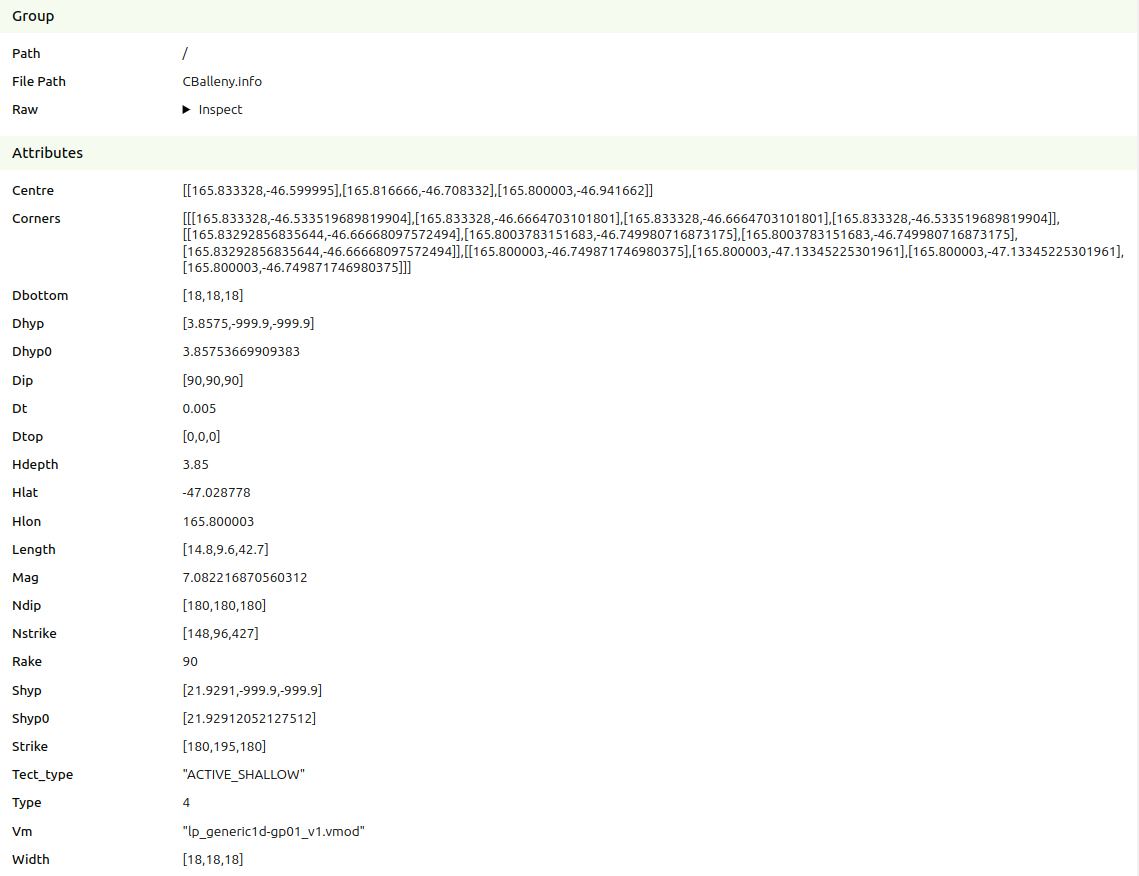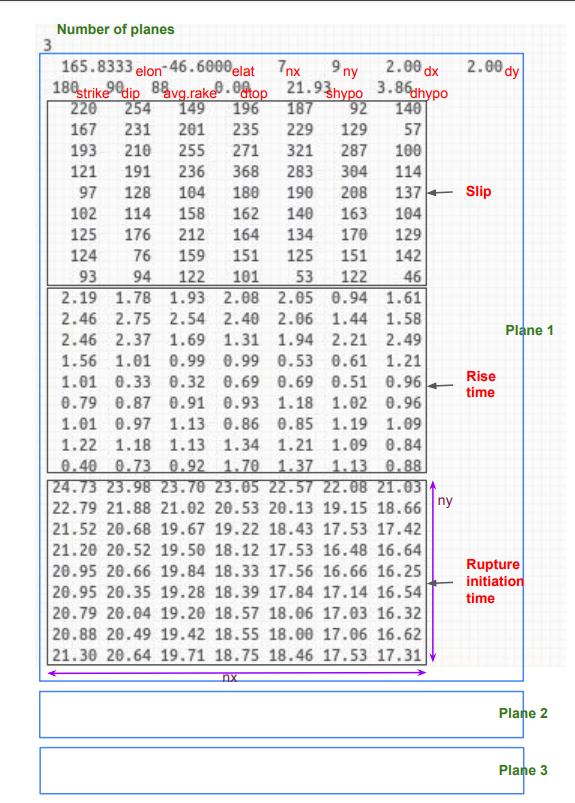This page has descriptions of the file formats that we use in various places.
| Table of Contents |
|---|
SRF
...
The .info files that accompany .srf files are in HDF5 format. The filenames match with the exception of the extension.
All information is stored as attributes.
There are 4 types of SRF files that can be created, all SRF files are created directly or indirectly via createSRF.py.
| Type 1 | point source. appears as 1 plane with 1 subfault. |
|---|---|
| Type 2 | finite fault. a single plane created from point source attributes, it has an are determined by a magnitude scaling relation. |
| Type 3 | finite fault. a single plane created with specified parameters. |
| Type 4 | finite fault. a multiple plane fault. planes can be internally generated together and cut up (like plane extensions that continue at a different strike angle) or: separate cases where multiple SRFs are combined. where separate cases are used, each can have a delay time to synchronise rupture initiation time between cases. |
Common Attributes (always available)
| attribute | description |
|---|---|
| type | 1: point source, 2: finite fault from point source info, 3: single plane, 4: multiple plane |
| dt | slip time step (s) |
| rake | rake angles (type 1-3: single value, type 4: 2D list for cases, fault planes) |
| mag | magnitude (type 1-3: single value, type 4: list for each case) |
| hlon | hypocentre longitude for first fault (degrees) |
| hlat | hypocentre latitude for first fault (degrees) |
| hdepth | hypocentre depth for first fault (km) |
| corners | 4 corners (longitude, latitude) for each plane. derived parameter (shape of array is nplane, 4 corners, 2 lonlat values). |
SRF Plane Attributes (lists with a length matching number of fault planes)
naming taken from qcore/srf.py
| attribute | description |
|---|---|
| centre | top centre longitude, latitude |
| nstrike | number of subfaults along strike |
| ndip | number of subfaults along dip |
| length | length (along strike) of fault plane (km) |
| width | width (along dip) of fault plane (km) |
| strike | strike angle (degrees) |
| dip | dip angle (degrees) |
| shyp | hypocentre location along strike from top centre (km), -999.9 for plane extentions |
| dhyp | hypocentre location along dip from top edge (km), -999.9 for plane extentions |
| dtop | depth of top edge (km) |
| dbottom | depth to bottom of plane, derived parameter (km) |
Type 1 (point source) Attributes
| attribute | description |
|---|---|
| vs | vs at centroid depth (km/s) |
| rho | density |
Type 2 (finite fault from point source data) Attributes
| attribute | description |
|---|---|
| mwsr | magnitude scaling relation name |
| cd | centroid depth (km) |
Type 2+ (finite faults) Attributes
| attribute | description |
|---|---|
| vm | velocity model used (basename) |
| shyp0 | distance along strike (km) to hypocentre for each case from top left corner (strike = 0, dip = 0) |
| dhyp0 | distance along dip (km) to hypocentre for each case from top left corner (strike = 0, dip = 0) |
Optional Attributes (need to check if they exist)
| attribute | description |
|---|---|
| tect_type | tectonic type, taken from the NHM file in nhm2srf.py. known options: ACTIVE_SHALLOW VOLCANIC SUBDUCTION_INTERFACE |
Format
- https://strike.scec.org/scecpedia/Standard_Rupture_Format
- SRF-Description-Graves_2.0.pdf
- SRF File Format Version 1 (output of genslip): srf_description_version_1.pdf
- Details on Source Modelling : Source Modelling for GMSim
SRF info format
The .info files that accompany .srf files are in HDF5 format
Example (CBalleny.info)
Stoch format
LF/HF/BB binary format
These files store timeseries data. All formats follow a style derived from the LF seis format produced by EMOD3D:
...
HF and BB have gaps between the first 2 sections to allow future additions to section 1 without breaking backwards compatibility.
| LF | HF | BB |
|---|---|---|
i4 number of stations TOTAL 4 BYTES | i4 number of stations
i4 number of ray methods
i4 first ray method used TOTAL 288 BYTES | i4 number of stations TOTAL 788 BYTES |
START OFFSET 4 BYTES i4 index of station in input file TOTAL 48 BYTES * NUM_STATIONS | START OFFSET 512 BYTES f4 longitude of station (degrees) TOTAL 24 BYTES * NUM_STATIONS | START OFFSET 1280 BYTES f4 longitude of station (degrees) |
vs30ref (m/s) |
vs30ref (m/s) TOTAL 44 BYETS * NUM_STATIONS | ||
START OFFSET 0 FROM ABOVE f4 velocity (cm/s) timeseries in array dimensions: TOTAL 4 BYTES * PRODUCT_OF_DIMENTIONS | START OFFSET 0 FROM ABOVE f4 acceleration (cm/s^2) timeseries in array dimensions: TOTAL 4 BYTES * PRODUCT_OF_DIMENTIONS | START OFFSET 0 FROM ABOVE f4 acceleration (g) timeseries in array dimensions: TOTAL 4 BYTES * PRODUCT_OF_DIMENTIONS |
XYTS.e3d binary format
This file is produced by EMOD3D and contains a timeseries of ground motions on the XY plane. Unlike the LF seis files, this contains data at all grid points and may have a decimated resolution specified when running EMOD3D through the e3d.par file with the parameters dxts and dyts.
...
- simulation metadata
- INTEGERS
- number of first x gridpoint
- number of first y gridpoint
- number of first z gridpoint
- number of first timestep
- number of x gridpoints
- number of y gridpoints
- number of z gridpoins (always 1 by definition of X-Y file)
- number of timesteps
- FLOATS
- x spacing between given gridpoints (km)
- y spacing between given gridpoints (km)
- original (pre-decimated) grid spacing between gridpoints used in simulation (km)
- timestep in timeseries (s)
- model rotation of gridpoints (degrees)
- model centre latitude (degrees)
- model centre longitude (degrees)
- x spacing between given gridpoints (km)
- INTEGERS
- timeseries
- float array of velocities in the dimentions of timesteps, components (x, y, z), y grid positions, x grid positions.
Intensity Measure calculation
The IM calculation code will produce a number of text files (decided as of 25/05/2018). We will summarize them in the following.
...
| Code Block |
|---|
station, component, IM_1, IM_2, ...., IM_N |
Empirical IMs
As above the empirical intensity measures have a similar format:
| Code Block |
|---|
station, component, IM_1, IM_1_sigma, IM_2, IM_2_sigma, ...., IM_N, IM_N_sigma |
Notes: 1) the component for empirical IMs is always 'geom' 2) only total sigma is saved to the csv file
Rrup file
The file format for this is:
...
| Code Block |
|---|
identifier, rupture, type, date, version |
GSF File
The GSF file is used to define the geometry of a source in a source modelling problem. It is the first step in the SRF generation process after a realisation is read.
A GSF file contains three sections in order:
- Errata/Header section,
- Declaration of the number of points (N),
- The geometry description: N lines representing each point in the geometry.
There are utilities to read GSF files in the gsf module within qcore.
Errata/Header
The header consists of a number of commented lines, each beginning with # . Here is an example:
| Code Block |
|---|
# nstk= 179 ndip= 215
# flen= 17.0720 fwid= 21.2853
# LON LAT DEP(km) SUB_DX SUB_DY LOC_STK LOC_DIP LOC_RAKE SLIP(cm) INIT_TIME SEG_NO |
This is the typical output of fault_seg2gsf . The first line has the number of points in the strike and dip directions, respectively. Then the length and width of the fault, and the last line is a description of each column in the points section.
The header is skipped by programs parsing GSF files and may contain any number of lines. The Python GSF generator, for example, only prints out the column description.
| Code Block |
|---|
# LON LAT DEP(km) SUB_DX SUB_DY LOC_STK LOC_DIP LOC_RAKE SLIP(cm) INIT_TIME SEG_NO |
Declaration of the Number of Points
Immediately following the header, there is one line containing the number of points in the GSF geometry definition.
Geometry Description
The geometry description has N lines, where N is the number of points declared in the previous section. Each line has 11 space separated values representing one point in the geometry.
| Column | Description |
|---|---|
| LON | The longitude of the point. |
| LAT | The latitude of the point. |
| DEP | The depth of the point (in kilometres, with -10 meaning 10km below ground level). |
| SUB_DX | The subdivision length in the strike direction. |
| SUB_DY | The subdivision length in the dip direction. |
| LOC_STK | The fault segment strike. |
| LOC_DIP | The fault segment dip. |
| LOC_RAKE | The fault segment rake. |
| SLIP | The total slip at this point (cm), usually -1. |
| INIT_TIME | The initial rupture time of this point, usually -1. |
| SEG_NO | The number corresponding to the segment this point belongs to.: |

